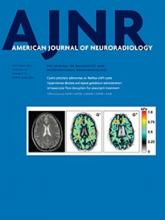Index by author
Gao, B.
- Adult BrainOpen AccessCytotoxic Edema in Posterior Reversible Encephalopathy Syndrome: Correlation of MRI Features with Serum Albumin LevelsB. Gao, B.X. Yu, R.S. Li, G. Zhang, H.Z. Xie, F.L. Liu and C. LvAmerican Journal of Neuroradiology October 2015, 36 (10) 1884-1889; DOI: https://doi.org/10.3174/ajnr.A4379
Gao, F.
- NeurointerventionYou have accessCombined Use of Mechanical Thrombectomy with Angioplasty and Stenting for Acute Basilar Occlusions with Underlying Severe Intracranial Vertebrobasilar Stenosis: Preliminary Experience from a Single Chinese CenterF. Gao, W.T. Lo, X. Sun, D.P. Mo, N. Ma and Z.R. MiaoAmerican Journal of Neuroradiology October 2015, 36 (10) 1947-1952; DOI: https://doi.org/10.3174/ajnr.A4364
George, L.
- EDITOR'S CHOICEFunctionalYou have accessSeizure Frequency Can Alter Brain Connectivity: Evidence from Resting-State fMRIR.D. Bharath, S. Sinha, R. Panda, K. Raghavendra, L. George, G. Chaitanya, A. Gupta and P. SatishchandraAmerican Journal of Neuroradiology October 2015, 36 (10) 1890-1898; DOI: https://doi.org/10.3174/ajnr.A4373
Resting-state fMRI data from 36 patients with hot-water epilepsy (18 with infrequent seizures) and 18 healthy age- and sex-matched controls were analyzed for seed-to-voxel connectivity. Patients in the frequent-seizure group had increased connectivity within the medial temporal structures and widespread areas of poor connectivity, including the default mode network. Seizure frequency can alter functional brain connectivity, which can be visualized by resting-state fMRI.
Gilbert, M.
- You have accessStandardized Brain Tumor Imaging Protocol for Clinical TrialsG.V. Goldmacher, B.M. Ellingson, J. Boxerman, D. Barboriak, W.B. Pope and M. GilbertAmerican Journal of Neuroradiology October 2015, 36 (10) E65-E66; DOI: https://doi.org/10.3174/ajnr.A4544
Goldmacher, G.V.
- You have accessStandardized Brain Tumor Imaging Protocol for Clinical TrialsG.V. Goldmacher, B.M. Ellingson, J. Boxerman, D. Barboriak, W.B. Pope and M. GilbertAmerican Journal of Neuroradiology October 2015, 36 (10) E65-E66; DOI: https://doi.org/10.3174/ajnr.A4544
Granata, F.
- Adult BrainOpen AccessMRI Tractography of Corticospinal Tract and Arcuate Fasciculus in High-Grade Gliomas Performed by Constrained Spherical Deconvolution: Qualitative and Quantitative AnalysisE. Mormina, M. Longo, A. Arrigo, C. Alafaci, F. Tomasello, A. Calamuneri, S. Marino, M. Gaeta, S.L. Vinci and F. GranataAmerican Journal of Neuroradiology October 2015, 36 (10) 1853-1858; DOI: https://doi.org/10.3174/ajnr.A4368
Gupta, A.
- EDITOR'S CHOICEFunctionalYou have accessSeizure Frequency Can Alter Brain Connectivity: Evidence from Resting-State fMRIR.D. Bharath, S. Sinha, R. Panda, K. Raghavendra, L. George, G. Chaitanya, A. Gupta and P. SatishchandraAmerican Journal of Neuroradiology October 2015, 36 (10) 1890-1898; DOI: https://doi.org/10.3174/ajnr.A4373
Resting-state fMRI data from 36 patients with hot-water epilepsy (18 with infrequent seizures) and 18 healthy age- and sex-matched controls were analyzed for seed-to-voxel connectivity. Patients in the frequent-seizure group had increased connectivity within the medial temporal structures and widespread areas of poor connectivity, including the default mode network. Seizure frequency can alter functional brain connectivity, which can be visualized by resting-state fMRI.
Halbach, V.V.
- EDITOR'S CHOICENeurointerventionYou have accessProgressive versus Nonprogressive Intracranial Dural Arteriovenous Fistulas: Characteristics and OutcomesS.W. Hetts, T. Tsai, D.L. Cooke, M.R. Amans, F. Settecase, P. Moftakhar, C.F. Dowd, R.T. Higashida, M.T. Lawton and V.V. HalbachAmerican Journal of Neuroradiology October 2015, 36 (10) 1912-1919; DOI: https://doi.org/10.3174/ajnr.A4391
Of 579 patients with intracranial dural arteriovenous fistulas, 545 had 1 fistula and 34 (5.9%) had enlarging, de novo, multiple, or recurrent fistulas. Of those 34 patients, 19 had progressive dural arteriovenous fistulas with de novo fistulas or fistula enlargement. Angioarchitectural correlates to chronically elevated intracranial venous pressures, such as venous sinus dilation and pseudophlebitic cortical venous pattern, were more common in progressive disease. Three young patients died despite endovascular, surgical, and radiosurgical treatments.
Hatt, A.
- FELLOWS' JOURNAL CLUBExtracranial VascularOpen AccessMR Elastography Can Be Used to Measure Brain Stiffness Changes as a Result of Altered Cranial Venous Drainage During Jugular CompressionA. Hatt, S. Cheng, K. Tan, R. Sinkus and L.E. BilstonAmerican Journal of Neuroradiology October 2015, 36 (10) 1971-1977; DOI: https://doi.org/10.3174/ajnr.A4361
The authors evaluated the effect of jugular compression on brain tissue stiffness and CSF flow by evaluating 9 volunteers, with and without jugular compression, with MR elastography and phase-contrast CSF flow imaging. The shear moduli of the brain tissue increased with the percentage of blood draining through the internal jugular veins during venous compression. Subjects who maintain venous drainage through the internal jugular veins during jugular compression have stiffer brains than those who divert venous blood through alternative pathways.
Hawkins, C.M.
- SOCIAL MEDIA VIGNETTEYou have accessSocial Media in Medical EducationR.T. Fitzgerald, A. Radmanesh and C.M. HawkinsAmerican Journal of Neuroradiology October 2015, 36 (10) 1814-1815; DOI: https://doi.org/10.3174/ajnr.A4136








